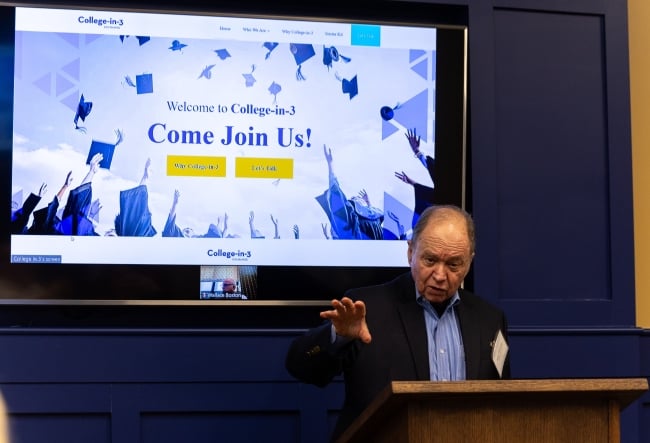You have /5 articles left.
Sign up for a free account or log in.

Bob Zemsky at this week's College-in-3 convening
Merrimack College
ANDOVER, Mass.—The stagnation and disinclination to experiment that many critics believe is rife in higher education may loom over some gatherings of campus leaders. The College-in-3 event here this week wasn’t among them.
Several dozen college administrators, faculty leaders, accreditors and others gathered at Merrimack College to share progress reports on, and commiserate about, common roadblocks in their efforts to create three-year bachelor’s degrees.
The gathering was organized by the College-in-3 Exchange, which has been working for several years to encourage institutions to design and build academic programs that deliver faster, less expensive, and—ideally—better degree programs for learners. Most of the institutions in the fledgling consortium, striving to redesign their way to a more secure future, would do so by reducing the number of academic credits they require from the typical 120 to as low as 90.
Progress has been slow, despite the missionary zeal of its chief advocates, Bob Zemsky, one of America’s best-known scholars and analysts of higher education, and Lori J. Carrell, chancellor of the University of Minnesota Rochester. By the time of last spring’s gathering at Georgetown University, not a single one of the then-12 pilot programs had been approved by their accreditors and states to begin operating.
Last fall, the Northwest Commission on Colleges and Universities approved three-year bachelor’s degree programs developed by Brigham Young University–Idaho and its affiliate Ensign College. But the accreditor’s officials say they won’t approve any other programs until they see outcomes, which they have yet to specify, from the two experiments in Idaho.
No other regulators have followed suit, and some institutions, like Merrimack, have been through the wringer, having submitted multiple proposals to no avail, its leaders say.
“Every time we come in, they change the rules again,” Chris Hopey, Merrimack’s president, said of the New England Commission on Higher Education. (Despite its apparent caution, the New England accreditor has taken incremental steps. It released guidelines last month that, among other things, would require institutions seeking to offer bachelor’s degrees with fewer than 120 credits to add a prefix to the name—think “applied” or “accelerated”—that would make clear to prospective applicants that it isn’t a traditional bachelor’s degree.)
Signs of momentum have appeared in recent weeks. Indiana’s legislature approved a measure last month that would require all four-year public colleges in the state to develop three-year degree options by July 2025. U.S. Senator Amy Klobuchar, a Minnesota Democrat, successfully tucked into a 2024 spending bill a provision that would let colleges use federal financial aid funds to try three-year degrees, through the Education Department's “experimental sites” program.
And the College-in-3 group unveiled an ambitious new strategy at this week’s meeting that would identify a handful of regional “host” institutions that would each build and help sustain “clusters” of 50–75 colleges and universities that pilot three-year-degree experiments.
Perhaps the most promising development was unveiled at the tail end of this week’s meeting—and may have been spurred by it. Zemsky and Carrell had invited officials from the Northwest accreditor and of the nation’s largest accreditor, the Higher Learning Commission, to the event, to help them learn more about the efforts, and, almost certainly, to gently apply pressure on them.
The accreditors took their lumps, as one session that was purportedly designed for institutions to share their stories largely morphed into a gripe-fest about the barriers state laws and accreditation processes had placed in their way.
Soon after, Tom Bordenkircher, vice president of accreditation relations at the Higher Learning Commission, delivered welcome news: that after significant “study,” beginning in September, the agency will consider granting approval to any institution seeking to offer a “reduced-credit bachelor’s degree” in any program. There will be no pilot projects, he said, and no asterisks attached to the offerings.
“As of this morning, the gate has swung wide open at HLC,” Bordenkircher said.
The response was enthusiastic.
“I think this will force the hands of other [accreditors],” said Hopey of Merrimack. “This is going to be cascading. Everybody’s waiting for who does it first.”
How Change Happens in Higher Education
Like many potential innovations in higher education, this one has been gestating for a long while. Zemsky floated the idea 15 years ago in a series of articles and books, but “we got done in by the accreditors when we last tried this,” he said this week.
In the intervening decade, questions have only grown about higher education affordability, the value of college credentials and the sustainability of many institutions as the number of college-goers declines—and demographic declines loom.
That has resulted in shifts in the credentials learners are seeking (see this week’s data on dips in degrees awarded and increases in certificates granted by American colleges and universities this year) and a good bit of creative thinking by institutions about what academic credentials to offer and how to offer them.
But as is often true, given the fragmented nature of higher education and the lack of cross-institutional collaboration, innovation like this often happens in nooks and crannies—in one professor’s course, or one department’s major, or maybe in a partnership between two local colleges.
Multi-institution networks like the College-in-3 Exchange (and better-established ones such as Achieving the Dream and the University Innovation Alliance) can help ideas spread.
Zemsky’s and Carrell’s vision to create a community of practice to encourage experimentation with three-year degrees as a partial response to the concerns about affordability and value, driven particularly, they say, by a single statistic: “Currently half of all four-year American colleges and universities across the United States lose a quarter or more of their first-year students before their second year,” with low-income, minority and first-generation students faring particularly poorly. “This outcome is unacceptable and we who serve students pursuing higher education must lead the change. We need not just new, but dramatically different designs—to achieve dramatically different results.”
The work of that community of practice was on display in the conference room at Merrimack, where officials from institutions as diverse as Georgetown (private research university), Utah Tech University (a regional public institution that offers a range of credentials) and American Public University (a for-profit institution that serves many military service members) brainstormed about how they might commonly measure the outcomes of the three-year degree programs they’re developing. They broadly agreed they would need to identify metrics around credential completion, student debt, employment, the student experience and student learning,
Participants discussed the importance of advising, and how to bring faculty members along, though most said their professors were energized by the possibility of rethinking their work on behalf of students.
And they talked about money: the need to build support from foundations for this work, and the extent to which that influenced the decision to adopt a strategy in which “host” institutions can play the intermediary role that many foundations today favor when they’re working in higher education.
Merrimack is the first such host to sign on, and Hopey said matter-of-factly that he would recruit 75 New England colleges to participate, plus 50 corporate CEOs to advocate and build momentum for the three-year degree.
Zemsky and Carrell set themselves an audacious goal of hundreds of three-year degree pilots within a few years. Given the low rate of accreditor approval so far, that target may have seemed almost laughable before this week’s statements from the Higher Learning Commission.
By the end of the meeting, though, optimism was high. “A year ago, our conversation had a ‘Debbie downer’ tone to it,” Hopey said. “This conversation has taken a 180.”









